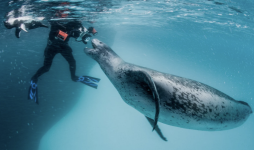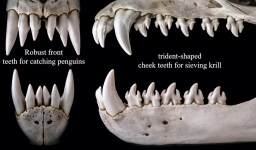Flicking through a 1752 bound edition of 'The Universal Magazine of Knowledge and Pleasure' (a monthly journal published in London) I've come across a few interesting tales (all apparently true) but this one I just read stood out above the rest. It goes thus.
January 25.
We have received the following relation from Trapani [Sicily], dated 18th of last month.
A fisherman being out in a little vessel near that port, unfortunately fell overboard, and was instantly snapt up by a monster resembling a large sea-dog, in sight of several other fishermen, who then made to shore with all speed, lest the monster should take a fancy to make a dinner of them next: but as soon as they had recovered from this panick, they considered the damage the monster might do to their fishery, and being likewise desirous to revenge the death of their comrade, they got divers iron instruments made, to which they fixed large steel hooks, and then went out in their boats in quest of the monster which had appeared several times before near that shore.
Having found him on the 6th of November, they baited their hooks with pieces of horse flesh; but this device did not succeed; the monster kept aloof as if it has suspected their design; wherefore they threw out a noose with a bait suspended in the middle of it, two or three men holding each end of the cord. This stratagem succeeded; the monster leapt at the bait so vigorously, that its whole head got thro' the noose, and the fishermen instantly pulling the rope, dragged it to shore.
It was twenty palms in length, and its mouth excessively large, with three rows of teeth in the upper jaw,; and the tail was six palms in length; the belly was not proportionate to the rest of the body, being only fourteen palms in circumference. It was a female, and weighed upwards of 4000lb. The next day the fishermen cut it up, and found in it a great quantity of fish, one half of a man's skull with the hair on, as also the two legs and part of the backbone and the ribs which they judged to be those of their unfortunate comrade that was devoured a few days earlier. They afterwards burned this monster lest it should infect the air. It appears from Pliny and other authors, that sea-monsters of this kind were known to the ancients by the name of Canis Catcharias.
So folks, what was this sea-monster with 3 rows of teeth? According to the OED it is "the common or harbour seal, Calocephalus vitulinus; ‘also (in California), one of the eared seals, Zalophus californianus’" but I have my doubts.
Interesting tale all the same.
Regards,
Jay.
January 25.
We have received the following relation from Trapani [Sicily], dated 18th of last month.
A fisherman being out in a little vessel near that port, unfortunately fell overboard, and was instantly snapt up by a monster resembling a large sea-dog, in sight of several other fishermen, who then made to shore with all speed, lest the monster should take a fancy to make a dinner of them next: but as soon as they had recovered from this panick, they considered the damage the monster might do to their fishery, and being likewise desirous to revenge the death of their comrade, they got divers iron instruments made, to which they fixed large steel hooks, and then went out in their boats in quest of the monster which had appeared several times before near that shore.
Having found him on the 6th of November, they baited their hooks with pieces of horse flesh; but this device did not succeed; the monster kept aloof as if it has suspected their design; wherefore they threw out a noose with a bait suspended in the middle of it, two or three men holding each end of the cord. This stratagem succeeded; the monster leapt at the bait so vigorously, that its whole head got thro' the noose, and the fishermen instantly pulling the rope, dragged it to shore.
It was twenty palms in length, and its mouth excessively large, with three rows of teeth in the upper jaw,; and the tail was six palms in length; the belly was not proportionate to the rest of the body, being only fourteen palms in circumference. It was a female, and weighed upwards of 4000lb. The next day the fishermen cut it up, and found in it a great quantity of fish, one half of a man's skull with the hair on, as also the two legs and part of the backbone and the ribs which they judged to be those of their unfortunate comrade that was devoured a few days earlier. They afterwards burned this monster lest it should infect the air. It appears from Pliny and other authors, that sea-monsters of this kind were known to the ancients by the name of Canis Catcharias.
So folks, what was this sea-monster with 3 rows of teeth? According to the OED it is "the common or harbour seal, Calocephalus vitulinus; ‘also (in California), one of the eared seals, Zalophus californianus’" but I have my doubts.
Interesting tale all the same.
Regards,
Jay.








